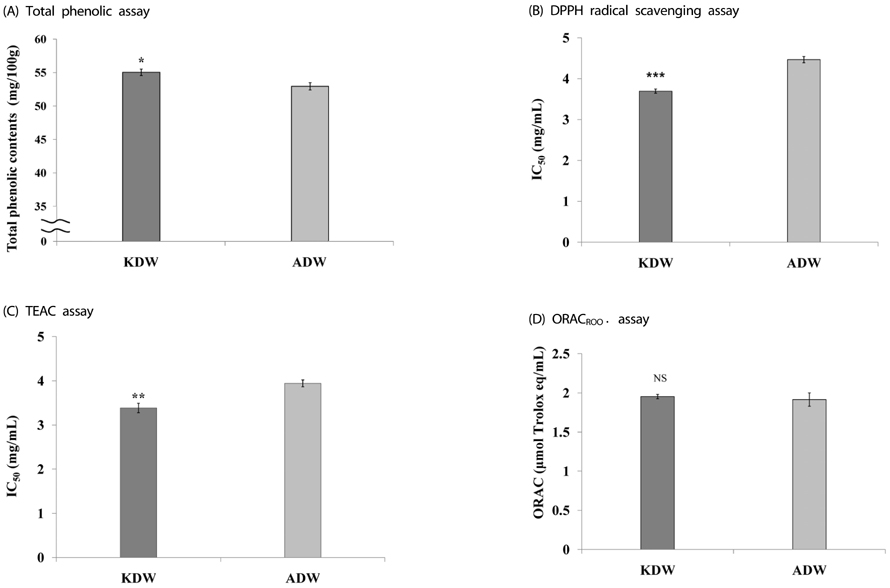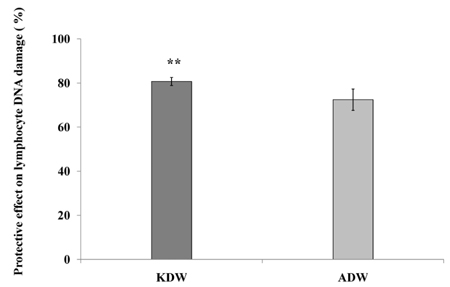Nutr Res Pract.
2017 Feb;11(1):33-42. 10.4162/nrp.2017.11.1.33.
Comparison of lymphocyte DNA damage levels and total antioxidant capacity in Korean and American diet
- Affiliations
-
- 1Department of Food Science and Nutrition, Daedeok Valley Campus, Hannam University, 461-6 Jeonmin-dong, Yuseng-gu, Daejeon 34054, Korea. mhkang@hnu.kr
- KMID: 2395291
- DOI: http://doi.org/10.4162/nrp.2017.11.1.33
Abstract
- BACKGROUND
/OBJECTIVE: This study aims to measure the in vitro antioxidant capacity of Korean diet (KD) with American diet (AD) as a control group and to examine the ex vivo DNA damage reduction effect on human lymphocytes.
MATERIALS/METHODS
The KD applied in this study is the standard one-week meals for Koreans (2,000 kcal/day) suggested by 2010 Dietary Reference Intakes for Koreans. The AD, which is the control group, is a one-week menu (2,000 kcal/day) that consists of foods that Americans would commonly take in according to the National Health and Nutrition Examination Survey. The antioxidant capacity of each menu was measured by means of the total phenolic assay and 3 in vitro antioxidant activity assays (2,2-diphenyl-1-picrylhydrazyl (DPPH) radical scavenging activity, trolox equivalent antioxidant capacity (TEAC), Oxygen radical absorbance capacity (ORACROO·)), while the extent of ex vivo lymphocyte DNA damage was measured by means of the comet assay.
RESULTS
When measured by means of TEAC assay, the in vitro antioxidant capacity of the KD of the day was higher than that of the AD (P < 0.05) while there was no significant difference in total phenolic contents and DPPH and ORAC assays. The ex vivo lymphocyte DNA damage protective effect of the KD was significantly higher than that of the AD (P < 0.01). As for the one-week menu combining the menus for 7 days, the total phenolic assay (P < 0.05) and in vitro antioxidant capacity (P < 0.001, DPPH; P < 0.01, TEAC) of the KD menu were significantly higher than those of the AD menu. Likewise, the ex vivo DNA damage reduction rate of the Korean seven-day menu was significantly higher than that of the American menu (P < 0.01).
CONCLUSION
This study demonstrates that the high antioxidant capacity and DNA damage protective effect of KD, which consists generally of various plant foods, are higher than those of typical AD.
MeSH Terms
Figure
Cited by 1 articles
-
Effects of lymphocyte DNA damage levels in Korean plant food groups and Korean diet regarding to glutathione S-transferase M1 and T1 polymorphisms
Hyun-A Kim, Min-Young Lee, Myung-Hee Kang
J Nutr Health. 2017;50(1):10-24. doi: 10.4163/jnh.2017.50.1.10.
Reference
-
1. Psaltopoulou T, Panagiotakos DB, Pitsavos C, Chrysochoou C, Detopoulou P, Skoumas J, Stefanadis C. Dietary antioxidant capacity is inversely associated with diabetes biomarkers: the ATTICA study. Nutr Metab Cardiovasc Dis. 2011; 21:561–567.
Article2. Suhail N, Bilal N, Khan HY, Hasan S, Sharma S, Khan F, Mansoor T, Banu N. Effect of vitamins C and E on antioxidant status of breast-cancer patients undergoing chemotherapy. J Clin Pharm Ther. 2012; 37:22–26.
Article3. Cocate PG, Natali AJ, Alfenas RC, de Oliveira A, dos Santos EC, Hermsdorff HH. Carotenoid consumption is related to lower lipid oxidation and DNA damage in middle-aged men. Br J Nutr. 2015; 114:257–264.
Article4. Strain JJ, Elwood PC, Davis A, Kennedy O, Coulter J, Fehily A, Mulholland CW, Robson PJ, Thurnham DI. Frequency of fruit and vegetable consumption and blood antioxidants in the Caerphilly cohort of older men. Eur J Clin Nutr. 2000; 54:828–833.
Article5. Liu S, Lee IM, Ajani U, Cole SR, Buring JE, Manson JE. Physicians' Health Study. Intake of vegetables rich in carotenoids and risk of coronary heart disease in men: the Physicians' Health Study. Int J Epidemiol. 2001; 30:130–135.
Article6. Hung HC, Joshipura KJ, Jiang R, Hu FB, Hunter D, Smith-Warner SA, Colditz GA, Rosner B, Spiegelman D, Willett WC. Fruit and vegetable intake and risk of major chronic disease. J Natl Cancer Inst. 2004; 96:1577–1584.
Article7. Gaziano JM, Hennekens CH. The role of beta-carotene in the prevention of cardiovascular disease. Ann N Y Acad Sci. 1993; 691:148–155.
Article8. Kim SH, Kim MS, Lee MS, Park YS, Lee HJ, Kang SA, Lee HS, Lee KE, Yang HJ, Kim MJ, Lee YE, Kwon DY. Korean diet: characteristics and historical background. J Ethn Food. 2016; 3:26–31.
Article9. Kim S, Moon S, Popkin BM. The nutrition transition in South Korea. Am J Clin Nutr. 2000; 71:44–53.
Article10. Lee MJ, Popkin BM, Kim S. The unique aspects of the nutrition transition in South Korea: the retention of healthful elements in their traditional diet. Public Health Nutr. 2002; 5:197–203.
Article11. Song Y, Joung H. A traditional Korean dietary pattern and metabolic syndrome abnormalities. Nutr Metab Cardiovasc Dis. 2012; 22:456–462.
Article12. Jung SJ, Park SH, Choi EK, Cha YS, Cho BH, Kim YG, Kim MG, Song WO, Park TS, Ko JK, So BO, Chae SW. Beneficial effects of Korean traditional diets in hypertensive and type 2 diabetic patients. J Med Food. 2014; 17:161–171.
Article13. Schroeder N, Park YH, Kang MS, Kim Y, Ha GK, Kim HR, Yates AA, Caballero B. A randomized trial on the effects of 2010 Dietary Guidelines for Americans and Korean diet patterns on cardiovascular risk factors in overweight and obese adults. J Acad Nutr Diet. 2015; 115:1083–1092.
Article14. Shin JY, Kim JM, Kim Y. Associations between dietary patterns and hypertension among Korean adults: the Korean National Health and Nutrition Examination Survey (2008-2010). Nutr Res Pract. 2013; 7:224–232.
Article15. Choi JH, Woo HD, Lee JH, Kim J. Dietary patterns and risk for metabolic syndrome in Korean women: a cross-sectional study. Medicine (Baltimore). 2015; 94:e1424.16. Saura-Calixto F, Goñi I. Antioxidant capacity of the Spanish Mediterranean diet. Food Chem. 2006; 94:442–447.
Article17. Park Y, Lee J, Oh JH, Shin A, Kim J. Dietary patterns and colorectal cancer risk in a Korean population: a case-control study. Medicine (Baltimore). 2016; 95:e3759.18. Serafini M, Del Rio D. Understanding the association between dietary antioxidants, redox status and disease: is the total antioxidant capacity the right tool? Redox Rep. 2004; 9:145–152.
Article19. Suh JH, Paek OJ, Kang YW, Ahn JE, Yun JS, Oh KS, An YS, Park SH, Lee SJ. Study on the antioxidant activity in the various vegetables. J Food Hyg Saf. 2013; 28:337–341.
Article20. Yang M, Chung SJ, Chung CE, Kim DO, Song WO, Koo SI, Chun OK. Estimation of total antioxidant capacity from diet and supplements in US adults. Br J Nutr. 2011; 106:254–263.
Article21. Russnes KM, Möller E, Wilson KM, Carlsen M, Blomhoff R, Smeland S, Adami HO, Grönberg H, Mucci LA, Bälter K. Total antioxidant intake and prostate cancer in the Cancer of the Prostate in Sweden (CAPS) study. A case control study. BMC Cancer. 2016; 16:438.
Article22. Han JH, Lee HJ, Cho MR, Chang N, Kim Y, Oh SY, Kang MH. Total antioxidant capacity of the Korean diet. Nutr Res Pract. 2014; 8:183–191.
Article23. Park YK, Jeon EJ, Kang MH. Protective effect of flavonoids on lymphocyte DNA damage using comet assay. Korean J Nutr. 2003; 36:125–132.24. Gafrikova M, Galova E, Sevcovicova A, Imreova P, Mucaji P, Miadokova E. Extract from Armoracia rusticana and its flavonoid components protect human lymphocytes against oxidative damage induced by hydrogen peroxide. Molecules. 2014; 19:3160–3172.
Article25. Jayakumar R, Kanthimathi MS. Dietary spices protect against hydrogen peroxide-induced DNA damage and inhibit nicotine-induced cancer cell migration. Food Chem. 2012; 134:1580–1584.
Article26. Müllner E, Brath H, Pleifer S, Schiermayr C, Baierl A, Wallner M, Fastian T, Millner Y, Paller K, Henriksen T, Poulsen HE, Forster E, Wagner KH. Vegetables and PUFA-rich plant oil reduce DNA strand breaks in individuals with type 2 diabetes. Mol Nutr Food Res. 2013; 57:328–338.
Article27. Prado RP, dos Santos BF, Pinto CL, de Assis KR, Salvadori DM, Ladeira MS. Influence of diet on oxidative DNA damage, uracil misincorporation and DNA repair capability. Mutagenesis. 2010; 25:483–487.
Article28. Switzeny OJ, Müllner E, Wagner KH, Brath H, Aumüller E, Haslberger AG. Vitamin and antioxidant rich diet increases MLH1 promoter DNA methylation in DMT2 subjects. Clin Epigenetics. 2012; 4:19.
Article29. The Korean Nutrition Society. Dietary Referece Intakes for Koreans. 1st rev. ed. Seoul: The Korean Nutrition Society;2010. p. 614.30. Korean Society of Food Science and Technology. Encyclopedia of Food Science and Technology. Seoul: Kwangil Publishing Co.;2004.31. Randhir R, Shetty P, Shetty K. L-DOPA and total phenolic stimulation in dark germinated fava bean in response to peptide and phytochemical elicitors. Process Biochem. 2002; 37:1247–1256.
Article32. Chen HM, Muramoto K, Yamauchi F, Fujimoto K, Nokihara K. Antioxidative properties of histidine-containing peptides designed from peptide fragments found in the digests of a soybean protein. J Agric Food Chem. 1998; 46:49–53.
Article33. Shon MY. Synergistic effect of methanol extract from kalopanax pictus and ascorbic acid on antioxidant, anticancer and immunomodulatory activities. J Life Sci. 2007; 17:1634–1640.
Article34. Kurihara H, Fukami H, Asami S, Toyoda Y, Nakai M, Shibata H, Yao XS. Effects of oolong tea on plasma antioxidative capacity in mice loaded with restraint stress assessed using the oxygen radical absorbance capacity (ORAC) assay. Biol Pharm Bull. 2004; 27:1093–1098.
Article35. Singh NP, McCoy MT, Tice RR, Schneider EL. A simple technique for quantitation of low levels of DNA damage in individual cells. Exp Cell Res. 1988; 175:184–191.
Article36. Park YK, Kim JS, Jeon EJ, Kang MH. The improvement of chaga mushroom (Inonotus Obliquus) extract supplementation on the blood glucose and cellular DNA damage in streptozotocin-induced diabetic rats. Korean J Nutr. 2009; 42:5–13.37. Lee KW, Cho MS. The development and validation of the Korean dietary pattern score (KDPS). Korean J Food Cult. 2010; 25:652–660.38. Zamora-Ros R, Serafini M, Estruch R, Lamuela-Raventós RM, Martínez-González MA, Salas-Salvadó J, Fiol M, Lapetra J, Arós F, Covas MI, Andres-Lacueva C. PREDIMED Study Investigators. Mediterranean diet and non enzymatic antioxidant capacity in the PREDIMED study: evidence for a mechanism of antioxidant tuning. Nutr Metab Cardiovasc Dis. 2013; 23:1167–1174.
Article39. Rockett JC, Burczynski ME, Fornace AJ Jr, Herrmann PC, Krawetz SA, Dix DJ. Surrogate tissue analysis: monitoring toxicant exposure and health status of inaccessible tissues through the analysis of accessible tissues and cells. Toxicol Appl Pharmacol. 2004; 194:189–199.
Article
- Full Text Links
- Actions
-
Cited
- CITED
-
- Close
- Share
- Similar articles
-
- Comparison of lymphocyte DNA damage levels and total antioxidant capacity in Korean and American diet
- Protective effect of Korean diet food groups on lymphocyte DNA damage and contribution of each food group to total dietary antioxidant capacity (TDAC)
- Effects of lymphocyte DNA damage levels in Korean plant food groups and Korean diet regarding to glutathione S-transferase M1 and T1 polymorphisms
- Comparison of the Protective Effect of Antioxidant Vitamins and Fruits or Vegetable Juices on DNA Damage in Human Lymphocyte Cells Using the Comet Assay
- Lymphocyte DNA Damage and Anti-Oxidative Parameters are Affected by the Glutathione S-Transferase (GST) M1 and T1 Polymorphism and Smoking Status in Korean Young Adults




